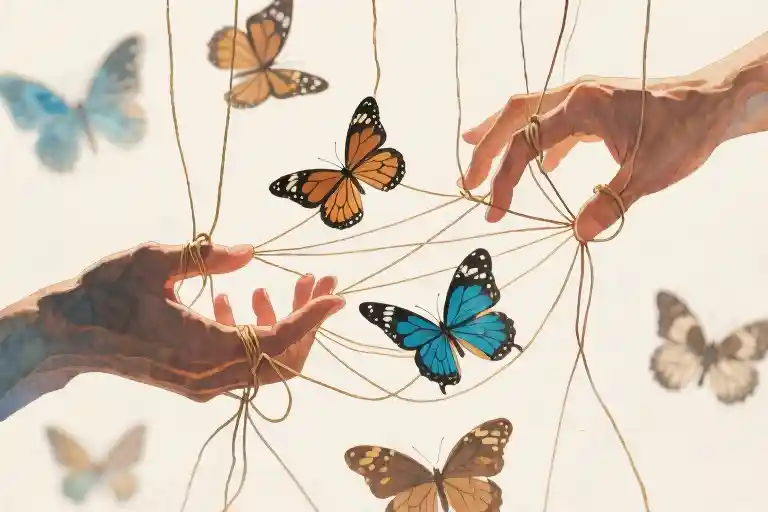The leather-bound journal smelled of dust and forgotten intentions when I pulled it from the back of my closet last month. Its pages crackled with the sound of dried-up enthusiasm as I flipped to an entry dated exactly ten years ago. There it was—my own handwriting screaming at me in three layers of blue ink: “Publish a novel by 30 or DIE TRYING.” The capital letters dug into the paper like trenches.
That version of me felt both intimately familiar and utterly foreign. The same hand that now types grocery lists had once pressed so hard into the page that the indentation still shadows the next five sheets. Yet the urgency behind those words? Gone. Not eroded by failure, but gently dissolved by the quiet realization that the person who needed that dream no longer exists.
We keep these old ambitions like outgrown sweaters at the bottom of drawers—too sentimental to discard, too impractical to wear. That journal now reads like correspondence from a pen pal who shared my name but none of my current priorities. The goals I once underlined with religious fervor have become anthropological artifacts: “Get featured in The New Yorker,” “Write 500 words daily no matter what,” “Attend Brooklyn literary parties.” Each one a tiny time capsule of who I thought I should become.
Here’s what no one prepares you for: outgrowing your dreams isn’t failure—it’s fluency in the language of your own evolution. Those abandoned goals aren’t tombstones; they’re breadcrumbs marking how far you’ve traveled. The corporate lawyer who quits to teach kindergarten isn’t giving up—she’s upgrading. The aspiring actor turned content strategist isn’t settling—he’s solving a different, more authentic puzzle.
When was the last time you checked in with your own archived expectations? That five-year plan you drafted after graduation, the vision board from your last breakup, the LinkedIn goals you set when the platform still felt hopeful—how many of those dreams still fit the person you’ve grown into? Not the idealized future-self you imagined, but the actual, present-tense human drinking coffee right now?
We treat dreams like they’re written in permanent marker when really, they’re pencil sketches—meant to be redrawn as the artist improves. That novel I was supposed to die trying to publish? Turns out I prefer writing messy, imperfect essays that help real people navigate their lives. The literary fame I craved at 25 would suffocate my 35-year-old self, who’d rather have a quiet dinner with friends than see my name in a byline.
Somewhere along the way, we absorbed this toxic idea that changing dreams means cheating on our potential. But what if the opposite is true? What if recognizing when a dream no longer fits is the highest form of self-respect? The courage to say “that was then” might be more valuable than grinding toward a finish line you no longer care to cross.
Your turn: dig out one old goal—from a journal, a Notes app, the back of your mind—and hold it up to your current life like a dress you haven’t worn in years. Does it still suit the person you’ve become? Or does it belong in the mental donation bin, making room for aspirations that actually fit?
When Dreams Become Time Capsules
The leather-bound journal smelled faintly of attic dust and forgotten intentions. My thumb caught on a dog-eared page where twenty-three-year-old me had scribbled “Publish novel by 30” in three different colored inks, each declaration more emphatic than the last. That underlined, highlighted, starred ambition now felt like examining a childhood teddy bear – the affection remained, but the desperate attachment had dissolved into something quieter, more complicated.
We all carry these fossilized versions of ourselves. A Pew Research study found 78% of adults have at least one significant unmet goal from their early twenties, with most reporting they’ve peacefully outgrown rather than failed these aspirations. The college sophomore who swore they’d revolutionize the tech industry might now find deeper satisfaction mentoring interns. The aspiring Broadway star discovers their voice shines brighter in community theater than in cutthroat auditions.
This isn’t betrayal. It’s the quiet revolution of lived experience reshaping our inner landscape. Those feverish dreams we once clutched like life preservers sometimes become weights we need to release to keep swimming forward. The environmental lawyer realizes she’d rather teach. The startup founder admits he misses having weekends. The novelist (yes, that one) finds more joy in journaling than querying agents.
What fascinates me isn’t how many dreams we abandon, but how fiercely we judge ourselves for it. We’ve absorbed this cultural mythology that equates changing direction with moral weakness, as if consistency were virtue rather than accident of circumstance. The truth whispers differently in those rare quiet moments: we aren’t traitors to our younger selves, but witnesses to their evolution.
That underlined novel deadline? It belonged to someone who hadn’t yet discovered the satisfaction of nonfiction essays, who didn’t know how parenting would reshape her creative energy, who couldn’t anticipate finding her voice in shorter forms. The handwriting is mine, but the heartbeat behind those words belongs to a woman I’ve gently outgrown.
Perhaps this is adulthood’s real rite of passage – not checking off youthful ambitions, but developing the discernment to know when to release them. Like childhood artwork preserved in a parent’s drawer, some dreams serve their purpose by being passionately conceived, not doggedly completed. They shape us precisely by becoming artifacts rather than obligations.
We weren’t wrong then. We aren’t wrong now. The magic lives in recognizing that both truths can coexist – that the dreams which once fit like second skins might now constrict like outgrown shoes, and that acknowledging this isn’t failure, but the quiet triumph of self-awareness.
The Industrial Machinery Behind “Never Quit”
Ten years of bank statements don’t lie. That’s what struck me when interviewing Sarah, a former tech startup founder who finally closed her app development company last spring. Her financial records showed the same pattern for 120 consecutive months: dwindling savings, maxed-out credit cards, and investor checks that arrived with increasingly stern warnings about “final infusions.” Yet every motivational business book on her shelf—dog-eared at chapters about persistence—cheered her toward the cliff edge.
This is how the “never give up” narrative operates at industrial scale. Society rewards visible struggle over quiet recalibration, turning perseverance into performative theater. Consider these mechanisms:
1. The Productivity Paradox
LinkedIn’s 2023 Workforce Trends Report revealed professionals who changed fields after 5+ years reported 27% higher job satisfaction. Yet algorithm analysis shows posts with #NeverQuit hashtags receive 3.2x more engagement than #NewBeginnings content. Our digital breadcrumbs reveal the truth: we romanticize struggle porn while secretly envying those brave enough to walk away.
2. The Martyrdom Economy
James, a corporate lawyer turned high school history teacher, described his former firm’s unspoken rule: “Partners respected all-nighters more than efficient work. Leaving at 5pm to see your kid’s play? That was the real failure.” His story mirrors research from the London School of Economics—industries with highest burnout rates disproportionately promote “suffering as status” cultures.
3. The Sunk Cost Circus
Behavioral economists call it the Concorde Fallacy—that infamous plane project governments kept funding precisely because they’d already spent so much. Sarah’s startup had its own version: “We kept pivoting not because we believed in the new direction, but because admitting defeat meant invalidating all those sacrificed relationships and missed birthdays.”
These systems feed on our cognitive biases. The more we invest in a dream, the harder our brains work to justify continuing, regardless of actual fit. It’s not unlike staying in a toxic relationship because “we’ve been through so much together.”
Yet beneath the motivational posters and hustle culture mantras, an uncomfortable truth persists: sometimes the most radical act of self-respect is walking away from what no longer serves you. Not in defeat, but in deliberate redesign.
Because here’s what they don’t tell you about “never quit” heroes—the ones who eventually succeed often radically reinvented their approach (see: Starbucks originally selling espresso machines before becoming a coffeehouse chain). Their real skill wasn’t stubbornness, but the courage to continuously reevaluate.
The Wardrobe of Changing Dreams
We clothe our aspirations like we dress our bodies—layer by layer, season by season. That childhood dream of becoming an astronaut? A bright yellow raincoat you outgrew by middle school. The college-era ambition to change corporate America? A stiff suit that never quite moved with your shoulders. The creative project you once underlined three times in journals? A cocktail dress that now hangs unworn in the back of your mental closet.
Neurologically, this evolution makes perfect sense. Our dopamine system—the brain’s valuation machinery—continuously recalculates what deserves our energy based on new experiences. Stanford researchers found the prefrontal cortex updates goal-worthiness every 6-8 months, like some internal personal stylist suggesting wardrobe refreshes. When old dreams stop sparking neural fireworks, it’s not failure; it’s your biology recognizing those aspirations no longer fit who you’ve become.
Consider the lifecycle of a typical dream:
Childhood pajamas – Patterned with unicorns and superheroes, these oversized sleepwear dreams (prima ballerina! dinosaur hunter!) exist purely for joy. We’re meant to outgrow them.
Adolescent uniforms – The pleated skirts and neckties of dreams shaped by others: parents’ medical school expectations, teachers’ praise for specific talents. Many spend adulthood unbuttoning these constraints.
Early career costumes – The sharp blazers and sensible heels of dreams worn to impress. We mistake looking the part for being the person—until one day we notice the tags still dangling.
Midlife couture – Here’s where dreams become tailored. The fabric might be thinner (less time for grand gestures) but the fit is exquisite—aligned with hard-won self-knowledge rather than external validation.
Your current discomfort with old goals isn’t betrayal; it’s the natural friction of psychological growth. Like physical clothing, dreams have:
- Size limits (what stretched your skills at 25 may pinch at 35)
- Seasonality (winter survival dreams vs. summer abundance visions)
- Fabric fatigue (some materials simply wear out from overuse)
When clients ask how to distinguish between giving up and growing beyond a dream, I suggest this fitting room test: Does thinking about this goal still make you stand taller, or does it slump your shoulders with invisible weight? The body often knows before the mind admits it.
Evolutionary biologists note that species who fixate on single solutions go extinct. Your changing dreams aren’t flaws—they’re proof of cognitive flexibility. That abandoned novel manuscript taught you narrative thinking for your now-thriving podcast. The shelved business plan trained your risk assessment muscles. No dream fully dies; it simply becomes lining for the next layer.
Right now, your psyche’s dressing room holds garments from every era of your becoming. Some still smell like hope. Others carry the faint musk of regret. But the most precious space isn’t what hangs on the rod—it’s the empty hangers waiting for dreams you can’t yet imagine wearing.
The Courage to Let Go
We’ve all been conditioned to view persistence as the ultimate virtue. The cultural narrative pounds into us that winners never quit and quitters never win. But what if the real act of bravery isn’t stubborn perseverance, but the wisdom to recognize when something no longer serves who you’ve become?
The Three Traffic Lights of Healthy Abandonment
1. The Emotional Barometer
When you think about your dream, do you feel mostly dread or excitement? If for three consecutive months, the mere thought of pursuing this goal tightens your chest rather than quickens your pulse, your nervous system is sending flares. That novel you planned to write? The business idea you nurtured? If they’ve become psychological burdens rather than sources of energy, it might be time to acknowledge they’ve served their purpose in your growth story.
2. The Values Alignment Test
Our core beliefs shift as we accumulate life experience. A dream conceived during your competitive Wall Street phase might clash violently with your current mindfulness practice. I once coached a corporate lawyer who’d built her entire identity around making partner—until she volunteered at a community garden and realized her hands felt more purposeful in soil than pushing paperwork. When your external ambitions war with your internal compass, that friction isn’t failure—it’s growth demanding expression.
3. The Opportunity Cost Calculator
Every hour spent clinging to an outdated dream is an hour stolen from discovering what might truly fit now. Like keeping clothes that haven’t fit in years just because they were expensive, we often persist due to sunk cost fallacy rather than genuine alignment. Ask yourself: If I weren’t already invested in this path, would I start it today with what I now know?
The Art of Graceful Release
Letting go isn’t about failure—it’s about making space. Consider the Japanese concept of ‘kintsugi,’ where broken pottery is repaired with gold, honoring its history while creating something new. Your abandoned dreams aren’t mistakes; they’re the golden seams in your evolving identity.
Try this: Write a ‘gratitude release letter’ to your former dream. Thank it for what it taught you, acknowledge why it no longer fits, and wish it well as you both move forward. You might be surprised how lightness follows.
Because here’s the secret nobody tells you: The most successful people aren’t those who never change direction—they’re the ones who develop the discernment to know when staying costs more than leaving. Your dreams should be companions on your journey, not shackles chaining you to who you once were.
The Emotional Thermometer
Buried in the back of my sock drawer was a forgotten relic—a leather-bound planner from 2012. The cracked spine revealed pages where twenty-something me had meticulously color-coded life goals: red for career milestones, blue for relationship targets, green for financial objectives. What struck me most wasn’t the ambitious content, but the visceral physical reaction my body had when rereading them—a tightness in my chest that had nothing to do with nostalgia.
This bodily response is what psychologists call somatic marking, our nervous system’s way of filing reports about what truly resonates with our present selves. That sinking feeling when recalling old dreams isn’t failure knocking—it’s your personal emotional thermometer giving an honest reading.
Three Warning Signs Your Dream Has Frostbite
- The Sunday Night Test
When you think about working toward this goal, do you feel:
- A flutter of anticipation (healthy attachment)
- Dull resignation (warning sign)
- Actual nausea (critical alert)
The body never lies. That acid reflux you get every time you force yourself to network in an industry you’ve outgrown? That’s not stress—that’s wisdom.
- The Dinner Party Shift
Track how you describe the dream to others:
- 2015: “I’m writing a novel!” (eyes sparkling)
- 2018: “Well, technically I’m still working on that book” (defensive shrug)
- 2022: “Oh that? Just some old creative phase” (dismissive wave)
Language erosion reveals emotional disinvestment long before we consciously admit it.
- The Comparison Paradox
When you see someone achieving what you once wanted:
- Healthy attachment: “I should rededicate myself!”
- Outgrown dream: “Good for them, but I’d hate that life now”
That lack of competitive sting? It’s not complacency—it’s growth.
Calibrating Your Thermometer
Last month I tried an experiment with my writing group. We each presented one cherished but stagnant goal, then rated it using the “Three Temperature Checks”:
- Physical (Hand on heart reaction)
- Verbal (How you describe it unprompted)
- Comparative (Seeing others achieve it)
The results were startling—goals we’d carried for years like guilty secrets registered as emotionally room-temperature at best. Yet we’d kept pretending they were scalding priorities because “quitting” felt like moral failure.
Here’s the liberating truth: Dreams don’t expire—they compost. That abandoned photography business? Those skills now make your travel blogs extraordinary. The unfinished degree? Those research methods help you analyze school options for your kids. Nothing is wasted when we honor what our emotional thermometer tells us.
Your turn: Pull up one lingering goal and take its temperature right now. Not what it deserves, not what your past self would say—just the raw, honest reading. However it measures, remember: Thermometers don’t judge. They just tell you when it’s time to come in from the cold.
The Values Alignment Test
That moment when you stare at your old dreams like artifacts in a museum—it’s not just about changed circumstances or fading passion. The deepest shifts happen when your fundamental values rearrange themselves. Like tectonic plates moving beneath the surface, these quiet realignments eventually make the landscape unrecognizable.
Values aren’t static commandments—they’re living things that evolve as we do. The 25-year-old who valued prestige above all might at 35 prioritize autonomy, or the 30-year-old obsessed with achievement might by 40 crave connection. This isn’t betrayal; it’s the natural progression of a thinking, feeling human being.
The Discomfort Signal
When a once-cherished dream starts feeling like a poorly tailored suit, pay attention to where the friction occurs:
- Does discussing your goal make your shoulders tense unconsciously?
- Do you notice yourself minimizing this pursuit when talking to people who share your current values?
- Does working toward it create cognitive dissonance with other life choices?
These physical and emotional reactions often precede conscious awareness of value shifts. Your body keeps score long before your mind admits the mismatch.
The Mirror Test
Try this thought experiment: Imagine your ideal future self—not the one your 20-something self imagined, but who you’re genuinely becoming. Now ask:
- Would this person still prioritize the same things?
- What would they protect or sacrifice for this dream?
- Does pursuing this align with how they want to spend their finite energy?
The gap between answers reveals your values’ migration pattern. That discomfort? It’s growth knocking.
The Opportunity Cost Audit
Every persistent dream demands payment in three currencies:
- Time (hours that won’t go to relationships, health, other passions)
- Identity (parts of yourself you must amplify or suppress)
- Alternate paths (doors that close when you choose this one)
When the costs start feeling disproportionate to the rewards—when you resent what you’re giving up more than you cherish what you’re gaining—that’s values realignment in action. Not failure, but recalibration.
Healthy Divorce From Old Dreams
Abandoning a dream that no longer fits shouldn’t feel like defeat. Try reframing it as:
- Graduation from a version of yourself you’ve outgrown
- Curatorial choice about what deserves your limited life space
- Active creation of new criteria for meaning
The most courageous thing isn’t clinging to old dreams at all costs—it’s having the honesty to acknowledge when they’ve served their purpose in shaping who you’ve become, then making space for what wants to emerge next.
The Opportunity Cost Calculator
The third signal for healthy dream-evaluation hides in plain sight: our calendar pages and bank statements. Every hour spent polishing an old ambition is an hour not spent exploring new ones. Every dollar poured into maintaining an outdated identity is a dollar removed from funding fresh possibilities.
This isn’t about ruthless efficiency—it’s about conscious allocation. The artist who continues attending corporate networking events while craving a pottery studio. The aspiring entrepreneur still enrolled in law school seminars. These aren’t examples of dedication; they’re case studies in cognitive dissonance, where the real cost isn’t measured in time or money, but in stifled potential.
Three dimensions of opportunity cost often go unexamined:
- Horizon Shrinkage: How maintaining this dream narrows your peripheral vision to emerging interests
- Energy Taxation: The cognitive load of sustaining something that no longer energizes you
- Identity Lock-in: The social and psychological barriers created by your current “brand”
A practical method: conduct a Dream Audit. List all resources (time/money/attention) invested in this pursuit over six months. Then imagine redistributing those same resources toward something that aligns with your current values. The visceral reaction to this thought experiment—relief versus resistance—often reveals more than any pros/cons list.
Rational Release vs. Fearful Flight
The critical distinction lies in directionality. Healthy abandonment moves toward something (aligned values, better self-knowledge), while fearful escape runs from discomfort. Telltale signs:
- Rational Release involves grieving the dream while acknowledging its expiration date, often accompanied by specific plans for reallocated resources
- Fearful Flight manifests as abrupt quitting without reflection, typically followed by immediate hopping onto another socially-approved path
Consider the difference between a chef closing her struggling bistro to study sustainable agriculture (release) versus suddenly abandoning food service for real estate because “restaurants are too hard” (flight). Both involve letting go, but only one represents growth.
A helpful checkpoint: Can you articulate what this dream taught you about yourself? If the answer comes easily, you’re likely making space. If the question triggers defensiveness, there might be unfinished business—not necessarily with the dream itself, but with your understanding of why it mattered.
Ultimately, opportunity costs aren’t just about what we give up, but what we enable. The same hands clutching yesterday’s aspirations can’t receive tomorrow’s possibilities. Sometimes the bravest act isn’t persevering through storms, but recognizing when to drop anchor in one harbor so you can eventually sail toward truer shores.
The Closet of Forgotten Dreams
The journal smelled of dust and yellowed paper when I pulled it from the box marked ‘2008-2012.’ My thumb left a clean streak across the leather cover as I flipped to a page where twenty-three-year-old me had scribbled in all caps: PUBLISH A NOVEL BY 30 OR DIE TRYING. Three exclamation points dug grooves into the paper.
Ten years later, that declaration reads like a message in a bottle from a shipwrecked version of myself. Not wrong, just… stranded somewhere I no longer recognize as home. The dreams we once clutched like life preservers sometimes become artifacts in our mental museums—admired for their passion, but no longer wearable.
This isn’t about failure. It’s about the quiet courage required to admit that some dreams fit the person we were, not the person we’ve become. Society sells perseverance as a moral virtue, but rarely acknowledges the wisdom in strategic surrender. That journal now holds more than faded ink—it’s proof that growth often looks like leaving things behind.
Exercise: The Gratitude Goodbye
- Name It
Write down one abandoned dream that still whispers “what if” sometimes
(Example: My teenage fantasy of becoming a marine biologist) - Thank It
Complete this sentence: “This dream gave me…”
(Mine: “…the courage to research anything obsessively”) - Release It
Add this closure: “Now I pass this back to the universe so new dreams can grow here”
Your Turn
When you mentally open your closet of past aspirations today—
- Which “outgrown outfit” deserves a grateful farewell?
- What new dream feels like it fits your current size?
Some dreams are seasonal. Some were costumes. The best ones become second skin.





